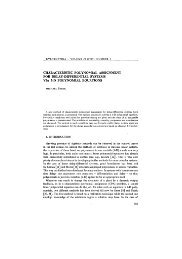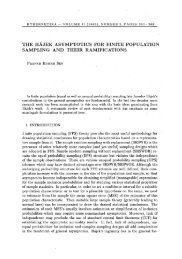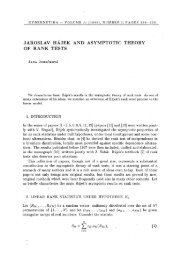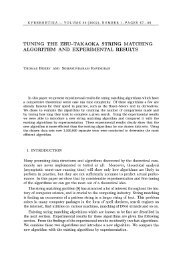polynomial controller design based on flatness - Kybernetika
polynomial controller design based on flatness - Kybernetika
polynomial controller design based on flatness - Kybernetika
Create successful ePaper yourself
Turn your PDF publications into a flip-book with our unique Google optimized e-Paper software.
Polynomial C<strong>on</strong>troller Design Based <strong>on</strong> Flatness 583<br />
C<strong>on</strong>trol u(t)<br />
0 1 2 3 4 5<br />
Flat output<br />
6 7 8 9 1<br />
0.5<br />
i .<br />
i<br />
Output systém<br />
r<br />
^<br />
Fig. 2. Tracking in the case of a = 1.<br />
8. CONCLUSION<br />
This paper showed that the use of a <strong>flatness</strong> point of view allows a simplificati<strong>on</strong><br />
in the <str<strong>on</strong>g>design</str<strong>on</strong>g> of high level parameters of RST <str<strong>on</strong>g>c<strong>on</strong>troller</str<strong>on</strong>g>s. The main feature of the<br />
<strong>flatness</strong> approach for RST <str<strong>on</strong>g>c<strong>on</strong>troller</str<strong>on</strong>g> <str<strong>on</strong>g>design</str<strong>on</strong>g> is to avoid the problem of the closed loop<br />
poles choice which are c<strong>on</strong>stituted of the observer poles and those obtained with a<br />
state feedback [2]. Now the <str<strong>on</strong>g>design</str<strong>on</strong>g> is focused in the choice of the trajectory Zd to<br />
follow and the tracking dynamics with K(p).<br />
In the case where a c<strong>on</strong>stant output perturbati<strong>on</strong>, for instance, is to be rejected,<br />
an integral acti<strong>on</strong> must be added in R. This can be achieved by forcing the presence<br />
of an integrator in the open loop transfer functi<strong>on</strong> as shown in the equati<strong>on</strong> (64).<br />
Then the proposed method can be applied again using a new operator n = p + a<br />
instead of the usual operator p.<br />
These developments were d<strong>on</strong>e in a c<strong>on</strong>tinuous-time framework, but are transposable<br />
for discrete-time systems [24]. In this case, the robustness of the proposed<br />
digital <str<strong>on</strong>g>c<strong>on</strong>troller</str<strong>on</strong>g> <str<strong>on</strong>g>based</str<strong>on</strong>g> <strong>on</strong> <strong>flatness</strong>, by introducing fixed <str<strong>on</strong>g>polynomial</str<strong>on</strong>g>s HR and Hs as<br />
proposed in [17], were treated for the flat discrete-time systems.<br />
REFERENCES<br />
(Received March 14, 2002.)<br />
[1] K. J. Astrom, B. Bernards<strong>on</strong>, and A. Ringdhal: Soluti<strong>on</strong> using robust adaptive pole<br />
placement. In: Proc European C<strong>on</strong>trol C<strong>on</strong>ference (ECC'91), Grenoble 1991, pp.<br />
1341-2346.<br />
[2] K. J. Astrom and B. Wittenmark: Computer C<strong>on</strong>trolled Systems, Theory and Design.<br />
Prentice Hall, Englewood Cliffs, N.J. 1990.<br />
[3] L. Bitaud, M. Fliess, and J. Levine: A <strong>flatness</strong> <str<strong>on</strong>g>based</str<strong>on</strong>g> c<strong>on</strong>trol synthesis of linear systems<br />
and applicati<strong>on</strong> to windshield wipers. In: Proc. European C<strong>on</strong>trol C<strong>on</strong>ference<br />
(ECC'97), Bruxelles 1997.






